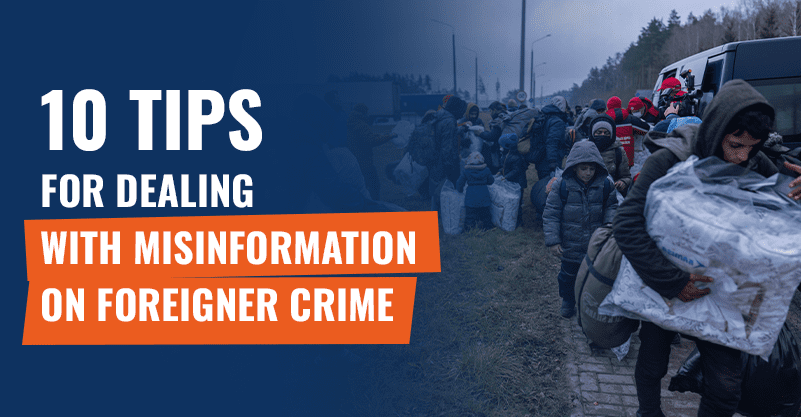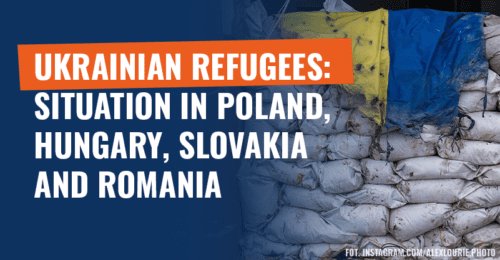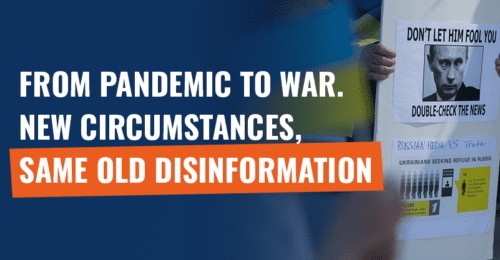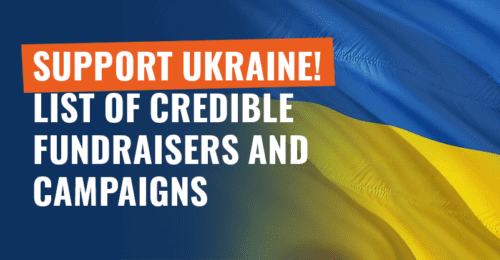10 Tips for Dealing with Misinformation on Foreigner Crime
We have compiled a series of tips on how to avoid being misled by misinformation about foreigner crime.

10 Tips for Dealing with Misinformation on Foreigner Crime
We have compiled a series of tips on how to avoid being misled by misinformation about foreigner crime.
This article is an abridged version of an analysis available here in Polish.
On the night of May 8-9, 2022, a murder took place on Nowy Świat Street in Warsaw. Some people and the media were quick to link the incident with the arrival of a large number of refugees to Poland and pointed out that the decision to allow people from Ukraine into our country was the leading cause of the crime. Some suspected or even still suspect Ukrainian nationals of committing this crime.
This may have been caused by a video showing a glimpse of the incident, made public by the warszawa.naszemiasto.pl portal. In the background of the clip, one can hear the so-called surżyk, which is a combination of Russian language with Ukrainian elements, which could have caused viewers to believe the crime was linked to refugees.
In fact, it is Poles who are wanted and prosecuted for committing the crime on Nowy Świat Street in Warsaw. A few days after the incident, the spokesman for the Capital Police Headquarters, Superintendent Sylwester Marczak, commented on the situation for Demagog, saying that “there are no circumstances indicating that the perpetrators are citizens of another country.”
Due to the many misinforming messages that have surfaced in relation to this event, we have decided to put together an “instruction manual” of dealing with reports on crime that foreign nationals may be involved in.
Disinformative narratives around crimes that foreigners are suspected of committing have appeared many times before in Europe. Therefore, we also asked other European fact-checking organizations about their experiences with misinformation about foreigner crimes, as well as an expert in criminology for help and consultation.
10 tips on how not to be misled about crimes that foreigners are suspected of committing

1. Stick to the facts. Speculation and opinions are not facts.
How to distinguish facts from opinions, speculations, or innuendos? First, it is worth realizing that a fact is neutral information about something that can be verified, and it is possible to prove what the message says is either true or false. Opinions and speculations, on the other hand, are the personal judgments by those expressing them, or conjectures and assumptions which truthfulness is impossible to establish.
In the case of events that receive massive public attention, we are often faced with the phenomenon of informational chaos. The multitude of messages, especially right after the event itself, makes it problematic to sort through the news and identify claims that are truthful. Sometimes, misinformation is not a direct result of bad intentions on the part of the publisher, but rather an effect of lacking the skills and time needed to separate false messages from those providing truthful information. Verified content is often lacking, especially right after the event, so most of the time recipients wanting to learn something about the incident end up with unverified information, which can then be used as an element of disinformation.
It is also worth checking who is publishing the news and whether they are trustworthy on that particular issue, e.g. if this person is a high-ranking official in the national justice system or an expert in criminology.
Factual information should be conveyed in an objective, emotionally neutral, and unbiased manner. An opinion is often written with emotionally imbued language, based on stereotypes and generalizations.
Let’s look at an example in the form of Twitter posts.
Precyzując: Prokuratura Okręgowa w Warszawie wystąpiła 17 maja o zastosowanie przez Sąd Rejonowy dla Warszawy Mokotowa tymczasowego aresztowania wobec ustalonych podejrzanych. W tej bulwersującej sprawie trudno sobie wyobrazić inną decyzję.
— Zbigniew Ziobro | SP (@ZiobroPL) May 20, 2022
Who publishes the information? Zbigniew Ziobro, who is the Minister of Justice and Public Prosecutor General. Due to his functions, he is responsible for overseeing the prosecution, so he can be considered a reliable source of information on its specific activities. This is an example of communication related to his responsibilities and not a political statement.
Can the information be verified? The Minister refers to institutions other than the Ministry of Justice in his posts. Among them are: The National Prosecutor’s Office, which has been instructed to take charge of the investigation, the District Prosecutor’s Office in Warsaw, which has applied for temporary arrest against the suspects, and the District Court for Warsaw Mokotów, which is to apply preventive measure of temporary arrest. One of Zbigniew Ziobro’s tweets includes the exact date when the request for temporary custody against the suspects was made by the Regional Prosecutor’s Office in Warsaw, making it easier to verify the information.
You can easily check that the Polish Police website has also posted information about the suspected Poles, which is in line with the message given by the minister. The police have also posted photos of the suspects to widen the search for the men.
What language is used in the message? The information was conveyed in an emotionally neutral manner and the message is informative.
Verdict: The statements contain facts. The last sentences of both entries (1, 2) are expressions of opinion. They read: “The perpetrators must be punished swiftly and severely” and “In this appalling case, it is hard to imagine a different decision.”
2. Remain vigilant when an issue is politicized.
The crime at Nowy Świat Street in Warsaw has attracted interest not only from ordinary social media users, but also from politicians.
Just a few days after the murder, when no suspects were yet identified, the fanpage of Ruch Narodowy (National Movement) published a post warning against “multicultural” politics and describing it as the reason for the crime.
U PROGU MULTI-KULTI W POLSCE
📣 To, przed czym 🇵🇱 narodowcy ostrzegali od wielu lat, za sprawą rządów PiS w Polsce staje się faktem. Nasz kraj staje się krajem coraz bardziej wielokulturowym. Granice zostały otwarte na masową imigrację do 🇵🇱 Polski. pic.twitter.com/S8NKAoT76C
— Ruch Narodowy (@RuchNarodowy) May 12, 2022
The post was accompanied by a graphic with the caption: “results of PiS policies: a 29-year-old Polish man killed by a foreigner in the middle of the street! PiS is turning Poland into a multicultural country! What we protested against in 2014-15 has already arrived. After the wave of rapes in pseudo-taxis, the MURDERERS begin! STOP multiculti!” The text was placed against a photo of Jaroslaw Kaczynski and a hand holding a knife, implying political responsibility of the PiS chairman for the young man’s death in Warsaw.
The post also points out that Polish borders “have been opened to mass immigration,” which is meant to suggest indirect involvement of authorities in the crime, since in light of the vision presented in the tweet, it was allowing immigrants to enter Poland that caused the man at Nowy Świat to die.
Through this post, Ruch Narodowy paints itself as a defender of the Polish people, outlining its past actions (such as the protests mentioned in the tweet) to prevent “opening doors to mass immigration.” The post suggests that if Ruch Narodowy was in power in Poland, the crime would not have happened because immigrants would not have been allowed into the country.
Based on false information that the perpetrators of the murder were Ukrainians, politicians of the National Movement were trying to use the crime for their political purposes. The tweet is used to trigger extreme emotions not only through a negative text but also through a suggestive knife picture, symbolizing the murder, juxtaposed with an image of Jarosław Kaczyński.
Some politicians tried to use the incident at Nowy Świat in Warsaw for political purposes. They presented themselves as defenders of Polish security in opposition to the “multicultural” policy of allowing foreigners into our country. Politicians who oppose the presence of foreigners in Poland suggest that if they were in power, they would not allow a crime like the one at Nowy Świat to happen.
3. Look for evidence, and verify information in reliable sources.
If the source of the information is not clearly stated in the news story, it is possible that it simply does not exist or the person publishing the material does not have it. The source of the information may also prove to be unreliable.
Reliable sources on crime are the official police and prosecution websites, both statewide and local structures.
As far as European data is concerned, it is worth looking for reliable information on the Council of Europe’s Annual Penal Statistics (SPACE I) website and in the European Sourcebook of Crime and Criminal Justice Statistics. Crime statistics are also available at Eurostat.
4. Remember: a suspect does not equal accused, and accused is not always guilty.
Rule of law implements the principle of the presumption of innocence, according to which a person who is suspected or accused of committing a criminal offense is presumed innocent until proven guilty in court. In Poland, this rule is codified through Article 5 of the Code of Criminal Procedure.
Tommaso Canetta from Pagella Politica, an Italian fact-checking organization, draws attention to the issue of presumption of innocence. In a commentary for Demagog, he urges not to draw hasty conclusions as long as the authorities’ activities are ongoing.
„The rule of law also applies to migrants and refugees! An official accusation is not the same as a conviction, and first instance conviction is not final”.
Tommaso Canetta from Pagella Politica for Demagog
The police are looking for the perpetrators of the Nowy Świat murder and are by no means hiding their identities. The images of the wanted men, in this case, have been made available to the public, and presented many times in country-wide media outlets (1, 2, 3, 4). However, this still doesn’t mean that the suspects are guilty of murder. The court will decide their guilt, not people commenting on social media.
At the current stage of the police investigation and the prosecutor’s office proceedings (the analysis was published on June 1st, 2022) it is not possible to state unequivocally that someone has been charged in the case of the murder committed at Nowy Świat, as well as if those people are guilty of committing the act.
5. Beware of unwarranted generalizations, and keep in mind that an individual situation does not apply to an entire nation.
The messages stating that one crime committed by a foreigner proves that all or most foreigners pose a threat to Polish residents are examples of unjust generalizations. This type of mechanism is also used in other disinforming content that tries to aggravate a sense of threat, uncertainty, and fear in the recipients.
Through generalization, the authors of such statements highlight the illegal behavior of individual foreigners, trying to convince that an individual situation is a typical behavior pattern for an entire group of foreigners. Such generalizations reduce a person only to their place of origin, omitting other important features.
However, criminologist habilitated doctor Woźniakowska-Fajst in her article “Foreigners as perpetrators of serious crimes in Poland – A research report” notes that “on the scale of Poland, homicides suspected of being committed by foreigners is a marginal issue”, which also translates to a small number of convictions of foreigners (p. 47).
„Ironically, this incident at Nowy Świat shows exactly how rare such situations are”.
Paweł Ostaszewski, PhD in conversation with Demagog
In 2019, 24 foreigners were suspected of committing homicide (p. 299). That year, there were 524 homicides in Poland.
6. Beware of misinterpreted statistics and remember that crimes are committed by people of every nationality, every religion, and every political view.
While there are studies comparing the scale of crime across countries and committed by people of different nationalities, this data is very complicated to analyze. When undertaking such comparisons, it is important to keep in mind that differences in the numbers of suspects committing specific categories of crime are not exclusively linked to the nationality of the perpetrators and victims, but also to many other circumstances.
The main problem that stands in the way of simple and quick analysis of crime data in various countries are different systems of crime registration. Another issue that also affects crime statistics is the differing criminal laws.
Key findings from the latest version of the “European Sourcebook of Crime and Criminal Justice Statistics”, the work result of an international group of experts, include information on crimes committed by foreigners. It shows that the highest percentage of foreigners in prison can be found in Luxembourg, Switzerland, and Austria.
These countries do not have the largest number of immigrants in Europe.
Germany ranks first in terms of long-term immigrants granted stay, followed by Spain, and France in the third place (taking into account the data through 2020 – information from after the outbreak of war in Ukraine could be misleading, as the most recent crime statistics are from before the Russian invasion began).
It should be noted that some countries record the ethnicity of the suspect, while others only provide his nationality (p.164). Again – these comparisons are extremely complicated.
Criminologist Paweł Ostaszewski, PhD in an interview with Demagog acknowledges that these analyses in general lead to the obvious conclusion: “migrants commit crimes like everyone else in the population.”
„This data (international statistics of foreigner crime – annotation by Demagog) also show that it is rather not the first generation of migrants who commit crimes. If there is already a slightly increased crime rate, it is rather due to the second generation of migrants, i.e. children who are already born in another country”.
Paweł Ostaszewski, PhD in an interview with Demagog
Questions about factors influencing crime rates among people from particular countries or of a particular nationality have been the subject of scientific research for years. They cannot be answered in one short Twitter post, which obviously, even if unintentionally, paints an oversimplified picture and leads to generalizations.
7. Approach photos and recordings with caution.
Both photographs and videos can be manipulated to change the meaning of the information they convey. The context in which the materials are presented is equally important – placing them in the wrong context can be an element of misinformation.
Even if we are certain that a photo or recording is original and has not been tampered with, it is important to carefully examine all verifiable aspects of it.
The video from the scene of the incident at Nowy Świat, which was published on the Internet, contributed to the dissemination of false information about the perpetrator of the crime. The person recording the video spoke a language combining elements of Russian and Ukrainian, which led some viewers to believe that the culprit of the incident was a person speaking that particular language.
8. Remember, an influx of foreigners does not equal more crime
In the article titled „On the crime of foreigners and crime against foreigners in Poland based on police statistics” Justyna Włodarczyk-Madejska et al. wrote that between 2013 and 2017, the number of foreigners among victims was 1.5 times higher than the number of foreigners suspected of committing a crime. In 2018 – 2019, those numbers remained at a similar level (p. 308).
If we consider women, the largest number of whom came to Poland due to the war in Ukraine, we find that the proportion of women among crime victims is about three times higher than that among suspects (pp. 292 – 293).
The authors of the article further note that “as a general rule, foreigners are less criminally involved than native-born residents and immigration itself does not contribute to an increase in crime” (p. 290).
As criminologist Paweł Ostaszewski, PhD emphasized in an interview with Demagog, “when comparing the numbers of foreign perpetrators and foreign victims, one should bear in mind that the number of victims is heavily underestimated, as these persons, for a number of reasons, are less inclined to report crimes than Poles”.
No matter how accurate the statistics might be, and regardless of the efforts of researchers trying to reach victims of crime, there remains a so-called “dark number” of crimes that neither the services, nor the researchers, nor the foundations and institutions dedicated to helping victims will ever know about.
At Demagog, we were confronting disinformation about foreigner crime way before the murder at Nowy Świat. When the first groups of refugees from Ukraine began arriving in Poland, there was a lot of information online about an allegedly increased crime rate in Polish border towns.
Despite the police officially denying those claims by saying that, “there is no increased crime as well as no increase in rape or harassment cases” caused by the larger number of refugees, these types of messages were numerous and popular.
You could find numerous false claims, such as information about an alleged knife attack on a young woman in Przemyśl, which was denied by the police, hospital and ambulance service, as well as reports of real incidents (an attack on a sales clerk in a grocery store in Medyka, an attack on a paramedic by a citizen of Turkmenistan), which, by generalizing, tried to convince that single incidents are evidence of all refugees engaging in the same type of behavior.
Similar conclusions can be drawn from a comment that Natalia Diez, project manager at Maldita Migración from the Spanish organization Maldita, made to Demagog. In Spain, this type of disinformation has also happened before. Natalia Diez gave the example of the entry of thousands of migrants across the border between Ceuta in Spain and Morocco in May 2021.
„Within hours, accounts of arsons, stabbings, rapes and other crimes supposedly taking place in Ceuta flooded Social Media.”
Natalia Diez from Maldita Migración for Demagog
In reality, these events never happened. Within days of the immigrants’ arrival, Maldita debunked 24 false messages about crimes that the foreigners were allegedly involved in.
9. Pay attention to the language used in messages.
We have mentioned the language used in disinforming content in most of the above paragraphs. Certain verbal mechanisms, including but not limited to generalizations also visible on a linguistic level, try to evoke negative emotions of fear, anxiety, or threat in the recipients.
„Fear fear might result in violence towards migrant communities and it also makes people spread the disinformation even faster”.
Natalia Diez from Maldita Migración in the commentary for Demagog
In relation to the language of information about foreigner crime, it is worth asking a few questions:
- Does the message contain terms that devalue foreigners?
- Is the language of the material emotionally-imbued? Does it evoke fear, uncertainty, anxiety?
- Is the message conveyed in such a way that it supports negative attitudes toward all refugees?
- Does the statement make suggestions not directly related to the event itself and extends to other, different situations?
If the answers to any of these questions are “yes”, it is likely that the message does not contain purely objective facts.
10. Be aware that most disinformation techniques have been around for years.
When it comes to manipulating the public opinion regarding foreigner crime, Polish authors of disinforming content haven’t reinvented the wheel. Most methods of distorting reality and manipulating facts have been known in other European countries for years. Similar messages about foreigner crime have already appeared in Germany and other countries.
Alice Echtermann, head of Correctiv.Faktencheck at the German organization Correctiv points out in a commentary for Demagog that these are “familiar patterns recurring for years, seeking to spread distrust and fear”.
„Before the pandemic, these kinds of claims about the criminality of refugees and migrants were the main topics we dealt with in Germany, except that they were mainly directed towards Muslims or refugees from Syria, Afghanistan, Iraq or African countries”.
Alice Echtermann, head of Correctiv.Faktencheck at the German organization Correctiv
Correctiv has written about cases similar to the events in Warsaw’s Nowy Świat, for example in 2019. At that time, Berlin police were searching for a sexual assault suspect, and misinforming materials claimed that the image of the wanted man depicted a Muslim.
This was done without any evidence, solely based on the “Arab-oriental appearance” allegedly visible in a photo provided by the police. A similar thing happened in the case of those responsible for the murder at Nowy Świat – the only proof that the perpetrators were Ukrainians, was the language that could be heard on the recording.
In the coverage of the crime described by Correctiv, there were theories that the police and media were purposefully trying to keep the man’s identity secret. This was also the case with the reporting on the Nowy Świat crime.
*If you find an error, highlight it and enter Ctrl + Enter







